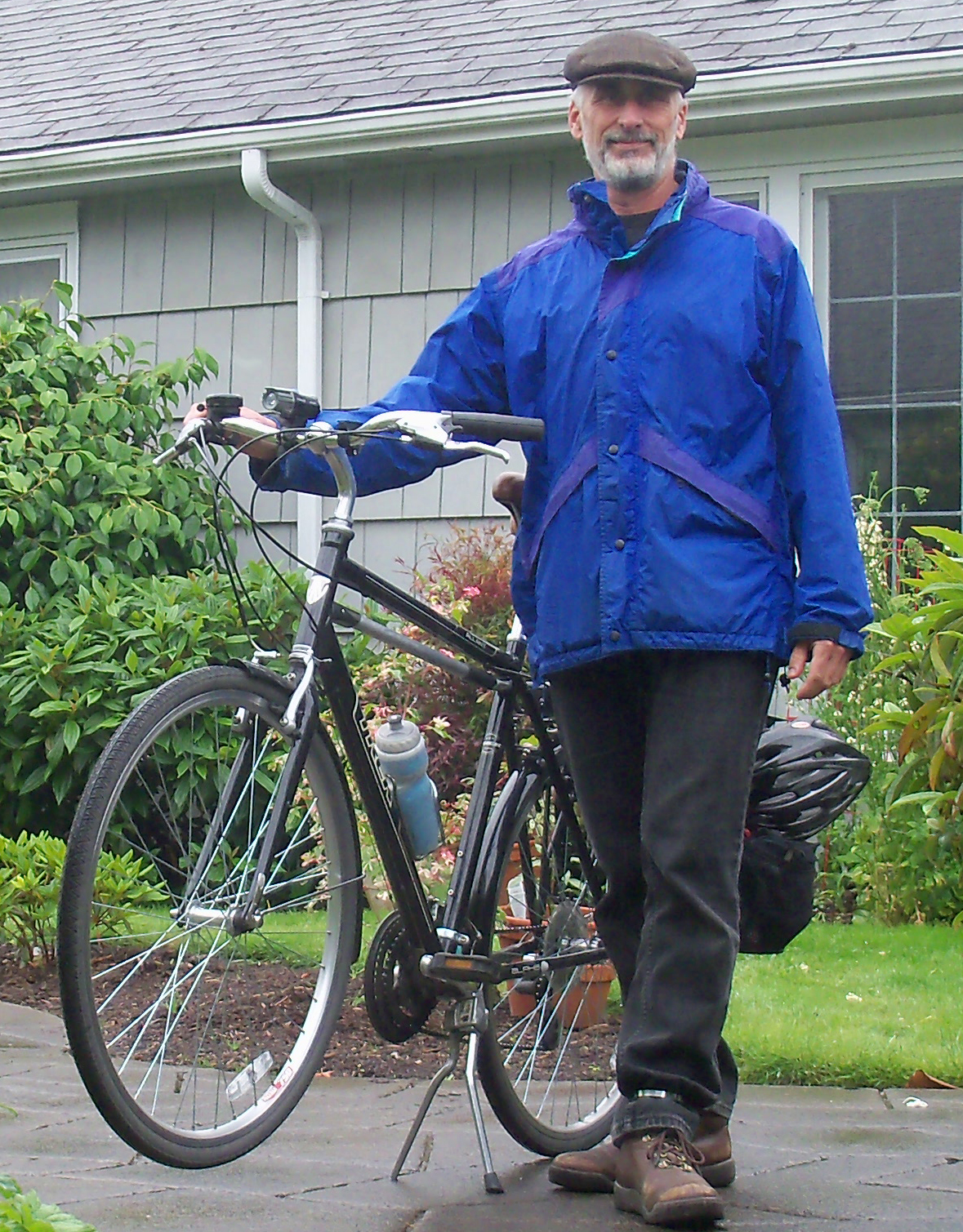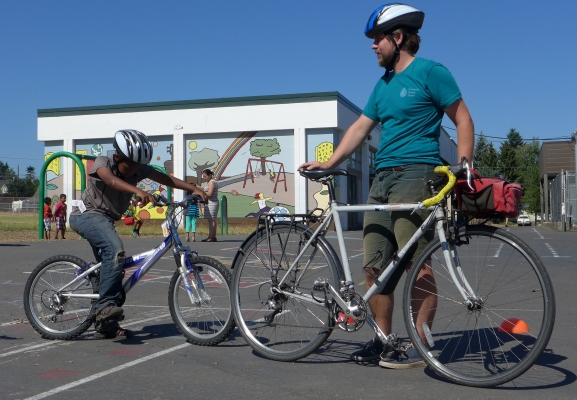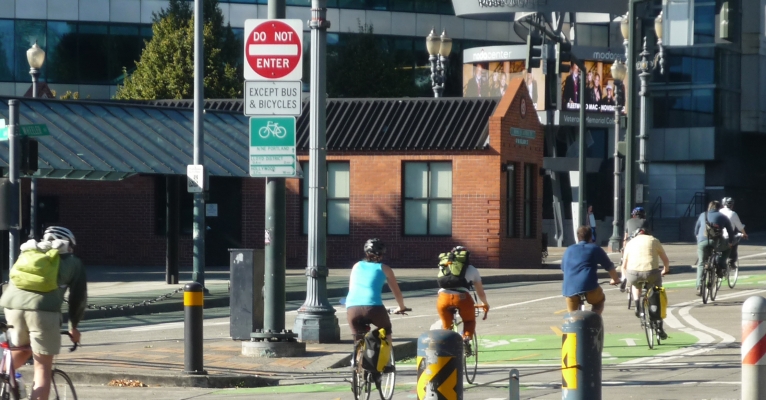View slides
Watch video:
The Community Cycling Center has been at the business of broadening access to bicycling for 22 years. Far before anyone was talking about "equity" in the world of bike commuting and advocacy, the Community Cycling Center was working directly with youth of color to make...
Read moreWatch video
View slides
Summary: In this seminar, Tara Weidner will discuss changes in the works to the State Analysis Procedures Manual (APM) to include three graduated levels of bike planning methods for use in Oregon communities, based on community size, data needs, and planning stage. These include the Bike Level of Traffic Stress (BLTS), a sketch tool used to assess bike network connectivity, the data-heavy Highway Capacity Manual Multi-modal Level of Service (MMLOS) procedures, and a simplified MMLOS developed by the same researchers.
Bio: Tara Weidner is an Integrated Transportation Analysis Engineer in ODOT’s Transportation Planning Analysis Unit (TPAU). She has over 20 years of experience in modeling and analysis of multi-modal transportation systems. Her work focuses on arming Oregon’s communities with tools to plan for the future, including being the lead on ODOT’s GreenSTEP Greenhouse Gas model and coordinating other multi-modal transportation and land use tools and analysis. She joined TPAU about a year ago after working as a Senior Planner for Parsons Brinkerhoff (PB), where she was the consultant lead for the ODOT StateWide Integrated Model (SWIM) and worked with the FHWA on Mega-Regions modeling tools and managed a webinar series on "Climate Change Planning for MPOs.
The video begins at 2:04.
Abstract: Findings will be presented on an evaluation of two innovative bicycle facilities installed in late summer and early fall 2009 in downtown Portland aimed at providing a more separated and comfortable experience for cyclists. The SW Broadway cycle track (near PSU) and the couplet of buffered bike lanes on SW Stark and SW Oak were evaluated to understand how they are functioning on multiple levels. Each facility involved removing a motor vehicle lane by restriping to provide additional roadway space to bicyclists. The facilities were evaluated after they had been in place for approximately one year. Data collected to support this evaluation consisted of surveys of multiple user groups for each facility type, and video data collected by the City of Portland Bureau of Transportation at intersections along each of the routes to understand the facilities' impact on traffic flow, operations and user interactions.
The video begins at 2:12.
Abstract: A new way of measuring Level of Service for bicycles, pedestrians, and transit is planned for the next Highway Capacity Manual. Are these the right tools to help us plan and build the system we want? If not, what answers do these tools give us and how should we use them? This presentation will review the approaches to multi-modal Level of Service at the national and local levels and discuss efforts to validate the HCM methods. It will also cover the effect of our LOS policies on climate change and explore ways that we might tweak our analysis to get a more accurate picture of the transportation system for all users.
Bio: Seleta Reynolds plans, funds, and implements bicycle and pedestrian projects as a consultant for the Seattle office of Fehr & Peers. Seleta contributed to the national Safe Routes to School toolbox and has served as a guest lecturer on transportation planning for San Jose State University, Portland State University, and UC Berkeley. She serves on the Transportation Research Board Pedestrian Committee and as the President of the Association of Pedestrian and Bicycle Professionals. One of her favorite side projects was a collaboration with artists Steve Lambert and Packard Jennings to imagine the future of transportation for the Art on Market Street project in San Francisco. Prior to joining Fehr & Peers in 2001, she was the bicycle and...
Read moreView slides
Watch video:
The City of Portland and the Metropolitan Region have strong policies in place to encourage transportation through means other than the single-occupancy vehicle. Both governments have numeric goals for the proportion of trips to be made by walking, bicycling, transit, shared vehicles, working at home and driving alone. Indeed, the City of Portland desires that by 2035 no more than thirty percent of commute trips be made by people driving alone. Similar policies have driven transportation planning in the city and region for decades.
To understand if these policies will be effective it's necessary to understand whether their antecedents have been effective. The Portland region has been investing in transit, bicycling and walking for more than two decades? Are we moving the needle? Have we been effective?
Roger's presentation will take a look at regional data for the period 2000-2014 to assess the effectiveness of our efforts and use that information to suggest pathways forward.
 Roger Geller has been Portland, Oregon’s bicycle coordinator since 2000...
Roger Geller has been Portland, Oregon’s bicycle coordinator since 2000...
Watch video
View slides
Summary: Urban bicyclists’ uptake of traffic-related air pollution is still not well quantified, due to a lack of direct measurements of uptake and a lack of analysis of the variation in uptake. This paper describes and establishes the feasibility of a novel method for measuring bicyclists’ uptake of volatile organic compounds (VOC) by sampling breath concentrations. Early results from the data set demonstrate the ability of the proposed method to generate findings for transportation analysis, with statistically significant exposure and uptake differences from bicycling on arterial versus bikeway facilities for several traffic-related VOC. These results provide the first empirical evidence that the usage of bikeways (or greenways) by bicyclists within an urban environment can significantly reduce uptake of dangerous traffic-related gas pollutants. Dynamic concentration and respiration data reveal unfavorable correlations from a health impacts perspective, where bicyclists’ respiration and travel time are greater at higher-concentration locations on already high-concentration roadways (arterials).
Bio: Alex Bigazzi is a Ph.D. candidate in Transportation Engineering at PSU, where he is also teaching a class on transportation emissions modeling....
The video begins at 2:58.
Abstract: While TriMet and other transit agencies serve many commuters by having racks for bikes on trains and buses, large bike parking facilities in global capitals of urban bicycling provide the key link between bikes and transit. Following the lead of European and Asian cities, the Portland region is starting to develop a network of bike-transit facilities; TriMet is piloting smart bike parking technology in the form of electronic bike lockers and "Bike & Rides". This presentation discusses the background and planning for bike-transit integration in the region and shares insights into bike-transit travel patterns, habits, and market segmentation gained from recent rider surveys.


